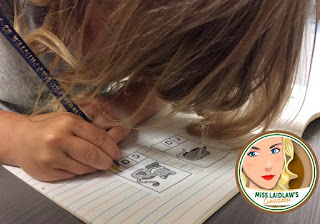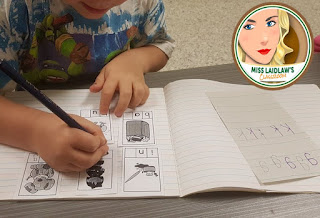Luckily, I was able to be a part of LDSB's MISA project a few years ago. It was led by our literacy consultant and we combined her passion for early literacy with some amazing things that are happening with our local Reading Clinic. We wanted to test with going back to the basics (phonics), individualized learning, and building a resource base to see if it made an impact on students' phonics knowledge, phonemic awareness, reading scores, and writing.
 |
| Our presentation board at the MISA Eastern Ontario sharing summit in 2017. |
We carefully tracked our data using assessments like phonics screeners, phonemic awareness (focusing on blending and segmenting), reading scores, writing samples, and spelling (I found Words Their Way as an excellent tool because it mirrors our phonics continuum almost perfectly!).
The phonics screener is an individual meeting with each student to find out which sounds of letters they know. The student is shown a letter and they have to tell its sound. For Ontario Kindergarten, we usually keep it to consonants and short vowels. However, several students know digraphs, long vowels, and a few advanced phonics like dipthongs by the end of the year. Knowing letter sounds is a specific goal in the play-based Ontario Kindergarten program. Because you're tracking it, it's very easy to show (and report on) growth in this area as key learning, if you want.
Now, here's the fun part - the part where you begin working with students. It can be done individually or as a group, as a warm-up or word work center, with a volunteer or Student Support Teacher, etc.. This is where the learning and growth starts. I'll write it as a list to help you with the steps. This is how I do it in SK/1 and Kindergarten - but there are many ways I've seen and heard this used (in grades all the way up to high school levels!).
- Students review the letters in their codepack. By themselves, with a peer, or an educator, students can flip through their known letters (information you get from their first phonics screener). Yes. We are only including their known letters. I keep their known letters loose and their unknown cards in an alligator clip in the case.
* As you continue and students master working with their known letters, begin to add 1-3 cards to their codepack's loose letters (how many and how often is up to you - you know the student best!). Incorporate those new pieces of phonetic code into the following activities to help ingrain it in memory and get your student comfortable working with it. Some students master code and add new cards very quickly - others need a lot more repetition and to go more slowly.
 |
| Why do we only work with letters we know (and slowly introduce new letters to learn)? Here's a piece I'd included in my shared writing blog post. |
- Choose some letters and set them out. I try to put out max 10 - fewer cards for struggling students. Make sure you include sounds you can combine to create words. You may choose to quickly review these sounds with the student, "Point to the card that says /p/. Now point to the one that says /th/."
- Now it's time to practice sound segmentation! Ask the student to use the cards to spell words (this is why you have to carefully choose the letters you have out). For example, "Can you use the cards to spell DOG? Let's sound it out together - /d/, /o/, /g/. What was the first sound? Which card here makes that sound? Okay, pull the /d/ down. What's the next sound you hear in the word DOG?" You can see how the goal is to have your student(s) begin to segment independently - and apply this during their independent writing.
- Let's integrate sound blending - a skill necessary for reading! The educator will use the cards to spell a word for the student. The student will need to put the sounds together to read the word. The magic is that the student already knows all of the sounds - they just need to put it together! This is a huge confidence-boost!
I was having troubles with students not being able to blend. I'm fairly certain it's because they were pointing to each letter and saying the sound individually - as if they were sound segmenting: /s/, /a/, /t/. Our literacy consultant helped me problem-solve this by modeling and having my students slide their finger along the word and hold the sounds, so it sounds more like "sssssssaaaaaaaat." I found a lot more success that way.
 |
| Here, a student has sound segmented to spell the word 'big' using their phonics cards. |
Now, I'll explain what I do beyond our codepack activities. Think of it as an extension. The codepack activity itself can take as little as 5 minutes, if needed, once you become efficient and get to know your students. I'll use photos to help explain and give an idea.
 |
| In a notebook (I use the half-size notebooks.), students glue in their phonics cards - which consists of this TPT product of mine photocopied 8-to-a-page. I select cards for sounds they know - ideally, sounds we just practiced using our codepack. Other things we focus on and I teach during this time, if needed: pencil grip & letter formation (do some of that Occupational Therapy work!). In my SK/1 class, I've done this as an independent warm-up, a word work center, guided work with me, and left it as an optional activity - always accessible to students (I glued a library pocket into the front and continually put new cards at the child's level in). Students would use a date stamp so I could observe progress. |
 |
| Sometimes, I added printing paper for students to practice their letter formation. It's important that students see you while you're writing the letter. Handwriting Without Tears is a popular resource for those of us who are unfamiliar with the conventional, "proper" ways of writing letters. I often came up with little stories to help students remember how the letter is written - for example, "A lowercase G is a c with a monkey tail that hangs below the line." We practiced tall, short, and hanging letters. I only used this strategy for difficult letters - and it was personalized (we never all practiced witing lowercase Gs together). I found this paper at the Dollar Tree store. |
 |
| Have you read my post about Shared Writing for Early Primary Students? You can read about it HERE! You can use your assessment data from the above activities to progress your students' writing. With shared writing, you can model so many other aspects of writing - see the full post for all the juicy details! |
Here's a FREE DOWNLOAD of the modified assessment tool and flashcards I've created. Get the document at https://www.teacherspayteachers.com/Product/Phonics-Assessment-and-Codepack-for-integration-with-Phonemic-Awareness-3916744.
I'm hoping you found this post helpful on your teaching journey. Have some ideas? Questions? Feel free to share by posting in the comments!

















